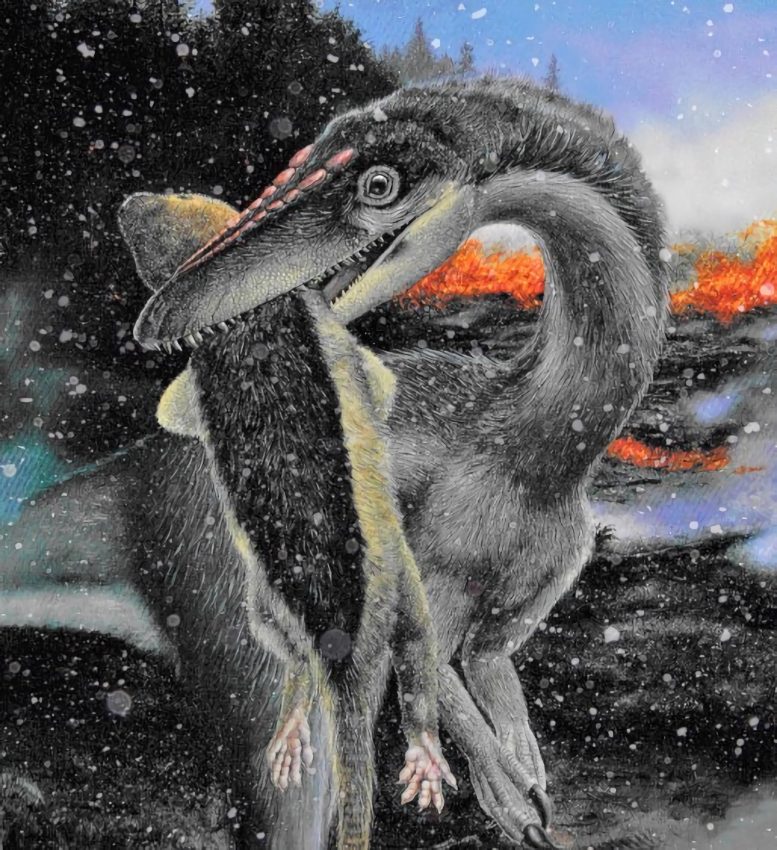
With a lava flow in the distance, a primitively feathered theropod dinosaur carries off a mammalian victim during a snowy volcanic winter caused by massive eruptions during the Triassic-Jurassic Extinction. A new study says dinosaurs survived because they were already adapted to freezing conditions at high latitudes. Credit: Painting by Larry Felder
Thriving in a Series of Sudden Global Chills That Killed Competitors
Many of us are familiar with the popular theory of how the dinosaurs died 66 million years ago: in Earth’s violent collision with a meteorite, followed by a global winter caused by dust and debris choking the atmosphere. But there was a far more mysterious and less discussed previous extinction: the one 202 million years ago, which wiped out the big reptiles who up until then ruled the planet, and apparently cleared the way for dinosaurs to take over. What caused the so-called Triassic-Jurassic Extinction, and why did dinosaurs thrive when other creatures perished?
We know that the world was generally hot and steamy during the Triassic Period, which preceded the extinction, and there were similar conditions during the following Jurassic, which kicked off the age of dinosaurs. However, new research turns the idea of heat-loving dinosaurs on its head: It presents the first physical evidence that Triassic dinosaur species, which were a minor group largely relegated to the polar regions at the time, regularly endured freezing conditions there.
The telltale indicators are dinosaur footprints along with odd rock fragments that only could have been deposited by ice. The authors of the study explain that during the extinction, cold snaps already happening at the poles spread to lower latitudes, killing off the cold-blooded reptiles. Dinosaurs, which had already adapted, survived the evolutionary bottleneck and spread out. The rest is ancient history.
“Dinosaurs were there during the Triassic under the radar all the time,” said Paul Olsen, a geologist at Columbia University’s Lamont-Doherty Earth Observatory, and lead author of the study. “The key to their eventual dominance was very simple. They were fundamentally cold-adapted animals. When it got cold everywhere, they were ready, and other animals weren’t.”
The study, based on recent excavations in the remote desert of northwest China’s Junggar Basin, was published today (July 1, 2022) in the journal Science Advances.
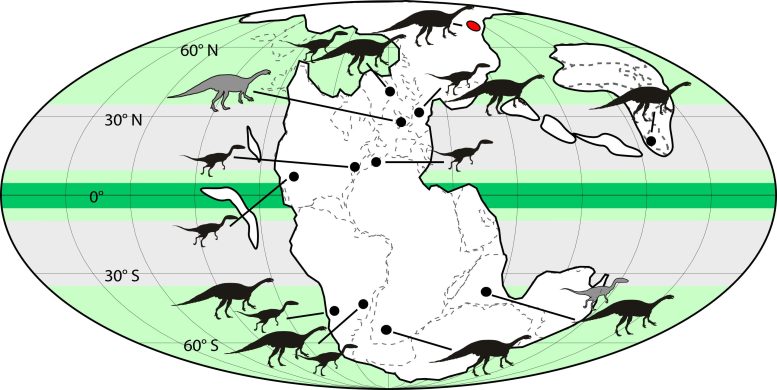
The supercontinent of Pangaea 202 million years ago, shortly before the Triassic-Jurassic Extinction. Evidence of early dinosaurs has been found in the indicated areas; most species were confined to the high latitudes, and those few nearer the tropics tended to be smaller. Red area at the top is the Junggar Basin, now in northwest China. Credit: Olsen et al., Science Advances, 2022
Dinosaurs are thought to have first appeared during the Triassic Period in temperate southerly latitudes about 231 million years ago, when most of the planet’s land was joined together in one giant continent geologists call Pangaea. They made it to the far north by about 214 million years ago. Until the mass extinction at 202 million years, the more expansive tropical and subtropical regions in between were dominated by reptiles including relatives of crocodiles and other fearsome creatures.
During the Triassic, and for most of the Jurassic, atmospheric concentrations of carbon dioxide ranged at or above 2,000 parts per million—five times today’s levels—so temperatures must have been intense. There is no evidence of polar ice caps then, and excavations have shown that deciduous forests grew in polar regions. However, some climate models suggest that the high latitudes were chilly some of the time; even with all that CO2, they would have received little sunlight much of the year, and temperatures would decline at least seasonally. But until now, no one has produced any physical evidence that they froze.
At the end of the Triassic, a geologically brief period of perhaps a million years saw the extinction of more than three-quarters of all terrestrial and marine species on the planet, including shelled creatures, corals, and all sizable reptiles. Some animals living in burrows, such as turtles, made it through, as did a few early mammals. It is unclear exactly what happened, but many scientists connect it to a series of massive volcanic eruptions that could have lasted hundreds of years at a stretch. At this time, Pangaea started to split apart, opening what is now the Atlantic Ocean, and separating what are now the Americas from Europe, Africa, and Asia. Among other things, the eruptions would have caused atmospheric carbon dioxide to skyrocket beyond its already high levels, causing deadly temperature spikes on land, and turning ocean waters too acidic for many creatures to survive.
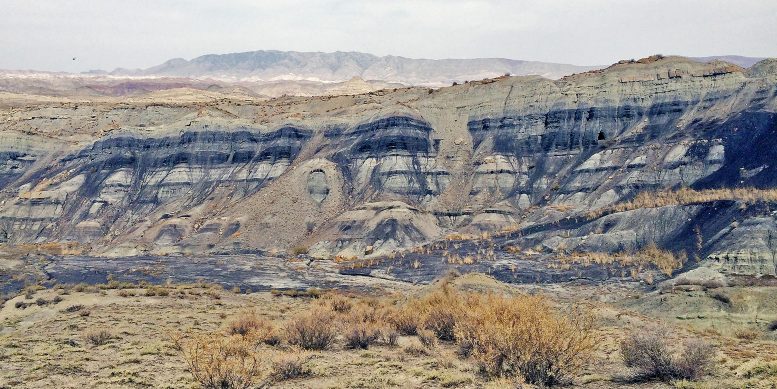
A shale cliff in the Junggar Basin in northwest China, where scientists found ice-rafted pebbles amid otherwise fine-grained sediments. Credit: Paul Olsen/Lamont-Doherty Earth Observatory
The authors of the new study cite a third factor: During the eruptions’ fiercest phases, they would have belched sulfur aerosols that deflected so much sunlight, they caused repeated global volcanic winters that overpowered high greenhouse-gas levels. These winters might have lasted a decade or more; even the tropics may have seen sustained freezing conditions. This killed uninsulated reptiles, but cold-adapted, insulated dinosaurs were able to hang on, say the scientists.
The researchers’ evidence: fine-grained sandstone and siltstone formations left by sediments in shallow ancient lake bottoms in the Junggar Basin. The sediments formed 206 million years ago during the Late Triassic, through the mass extinction and beyond. At that time, before landmasses rearranged themselves, the basin lay at about 71 degrees north, well above the Arctic Circle. Footprints found by the authors and others show that dinosaurs were present along shorelines. Meanwhile, in the lakes themselves, the researchers found abundant pebbles up to about 1.5 centimeters across within the normally fine sediments. Far from any apparent shoreline, the pebbles had no business being there. The only plausible explanation for their presence: they were ice-rafted debris (IRD).
Briefly, IRD is created when ice forms against a coastal landmass and incorporates bits of underlying rock. At some point, the ice becomes unmoored and drifts away into the adjoining water body. When it melts, the rocks drop to the bottom, mixing with normal fine sediments. Geologists have extensively studied ancient IRD in the oceans, where it is delivered by glacial icebergs, but rarely in lake beds; the Junggar Basin discovery adds to the scant record. The authors say the pebbles were likely picked up during winter, when lake waters froze along pebbly shorelines. When warm weather returned, chunks of that ice floated off with samples of the pebbles in tow, and later dropped them.
“This shows that these areas froze regularly, and the dinosaurs did just fine,” said study co-author Dennis Kent, a geologist at Lamont-Doherty.
How did they do it? Evidence has been building since the 1990s that many if not all non-avian dinosaurs including tyrannosaurs had primitive feathers. If not for flight, some coverings could have been used for mating display purposes, but the researchers say their main purpose was insulation. There is also good evidence that, unlike the cold-blooded reptiles, many dinosaurs possessed warm-blooded, high-metabolism systems. Both qualities would have helped dinosaurs in chilly conditions.
“Severe wintery episodes during volcanic eruptions may have brought freezing temperatures to the tropics, which is where many of the extinctions of big, naked, unfeathered vertebrates seem to have occurred,” said Kent. “Whereas our fine feathered friends acclimated to colder temperatures in higher latitudes did OK.”
The findings defy the conventional imagery of dinosaurs, but some prominent specialists say they are convinced. “There is a stereotype that dinosaurs always lived in lush tropical jungles, but this new research shows that the higher latitudes would have been freezing and even covered in ice during parts of the year,” said Stephen Brusatte, a professor of paleontology and evolution at the University of Edinburgh. “Dinosaurs living at high latitudes just so happened to already have winter coats [while] many of their Triassic competitors died out.”
Randall Irmis, curator of paleontology at the Natural History Museum of Utah, and specialist in early dinosaurs, agrees. “This is the first detailed evidence from the high paleolatitudes, the first evidence for the last 10 million years of the Triassic Period, and the first evidence of truly icy conditions,” he said. “People are used to thinking of this as being a time when the entire globe was hot and humid, but that just wasn’t the case.”
Olsen says the next step to better understand this period is for more researchers to look for fossils in former polar areas like the Junggar Basin. “The fossil record is very bad, and no one is prospecting,” he said. “These rocks are gray and black, and it is much harder to prospect [for fossils] in these strata. Most paleontologists are attracted to the late Jurassic, where it’s known there are many big skeletons to be had. The paleo-Arctic is basically ignored.”
Reference: “Arctic ice and the ecological rise of the dinosaurs” by Paul Olsen, Jingeng Sha, Yanan Fang, Clara Chang, Jessica H. Whiteside, Sean Kinney, Hans-Dieter Sues, Dennis Kent, Morgan Schaller and Vivi Vajda, 1 July 2022, Science Advances.
DOI: 10.1126/sciadv.abo6342
The study was co-authored Jingeng Sha and Yanan Fang of Nanjing Institute of Geology and Paleontology; Clara Chang and Sean Kinney of Lamont-Doherty Earth Observatory; Jessica Whiteside of the University of Southampton; Hans-Dieter Sues of the Smithsonian Institution; Morgan Schaller of Rensselaer Polytechnic Institute; and Vivi Vajda of the Swedish Museum of Natural History.


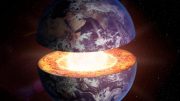

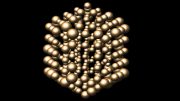


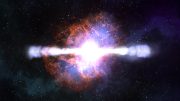
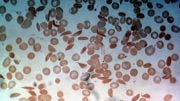
So… The dinosaurs were Warm-blooded after all! Might hive credence to what some contend: That the Velociraptor is a distant relative of Human Beings… Might explain much about Human History and the pursuit of Wealth and Power..
👑🦖🦖🦖
What??
Dinosaurs being warm blooded is not a new theory. And we are descended from mammals who survived those extinctions, not dinosaurs. Birds are the dinosaurs that survived. All non-avian dinosaurs went extinct.
Evidence is building tyrannosaur had feather is more like corruption was building in the 90 s and by corrupt movie Jurassic park but in dinosaur corruption was at the start .claiming that dinosaur is more advance than the gator the gator is greatest dinosaur ever the greatest tyrannosaur ever the greatest spinosauridae ever.the gator is a tyrannosaur it has no feather it can take extreme cold they can live out side the subtropical like New York Canada South Pole there is a fossil of the gator in Canada North Pole island and a mesoeucrocodylia fossil from the South Pole scitech daily did a article about it i guest these scientist do not read scitech daily and do not know any thing about dinosaur or crocodilian .allso dwarf caiman live in the mountain love cold water the snow run off water no problem hunting in those water .yes modern crocodilian performance is of warm blooded animal because they are warm blooded animal clearly by the heart the better kidney than mammal and a advance spleen and fatty battery mammal and gator love useing that.before handbag were popular the state north of North Carolina had gator the snowy North Carolina still has gator .the tetanuran gator can take the cold .200 million years ago the first gator type mesoeucrocodylia appear the dinosaur type mesoeucrocodylia is older .that is spinosauridae a animal like baryonyx or spinosaurus .the death roll finish rest of the dinosaur that did not have a death roll .the death roll is the greatest dinosaur technology .other story Nile crocodile does not have lacrimal foramen were you find in advance dinosaur like all tetanuran and advance 4 finger dinosaur .all modern crocodilian came from the Nile crocodile.only mugger crocodile has lacrimal foramen American gator allso has it .early gator type mesoeucrocodylia allso has it a none eusuchian mesoeucrocodylia .deevolution is so common in mesoeucrocodylia like ziphodont teeth some modern crocodilian lack archosaur feature they have primitive features the broad snout caiman and the black caiman these are the top of the line modern crocodilian .any way crocodile have 2 group they have once with more of a gator feature that why gharial could be the gator ancestor not the dwarf caiman .dwarf caiman have more feature but it is not extreme aquatic.gharial salt glands does not work like the gator and gharial lack fuse nose like the caiman .seem the missing animal is the raise of mesoeucrocodylia possiblyty the king of the beast the modern spinosauridae gator Nile crocodile is known to challenge things like tiger and lion and kill them .I Know won thing it is scientific impossible for dinosaur to defeat modern crocodilian .gator is alive 6 bone fuse to braincase.spinosauridae live tyrannosaur live .spinosauridae live thanks to fully secondary bony palate allways a high tech feature .human a mammal lack fully secondary bony palate it secondary palate lack bone it’s fleshy palate only one full bony palate a feature of mammal and t.rex .that one full palate of t.rex just can not get the job done against spinosaurus do the math spinosaurus have a bite force of two skull t.rex have a bite force of one skull do the math .snout size the winner spinosauridae do the math snout size = bigger the palate the bigger the bite force.Nile crocodile is alive .gator heart is more advance than mammal and birds.
Assuming that our “fine feathered friends” could survive the cold at the poles, what did they eat? Both cold and lack of sunlight shut down photosynthesis. Plants didn’t grow feathers to keep warm. Without actively growing plants, the herbivores would quickly devour all the vegetation within reach. When the herbivores died, the carnivores would have been reduced to scavenging frozen carcasses, which they don’t seem to be adapted for.
I think that there are a lot of unexamined assumptions in this thesis.
In dinosaur time it was subtropical at North Pole and south pole in the middle tropical so the plant will grow . It was not like New York and the Penn state with there extreme winter .a feral gator survive many winter in the Penn state it was shot later .gator can survive extreme winter and frozen pond there video on YouTube about that American crocodile get kill in Miami all the time from the cold they survive thou common caiman invasive species allso survive they are not cold hardy there native land is very tropical.they claim lack of sun light in the north pole make dinosaur better than a gator .this Show clearly they know nothing about modern crocodilian .modern crocodilian is well design for the night they have cat eyes that glow they do not need sun like other reptile that why they can live in cave 2 species does that today at Disneyland gator kill someone at night it was a big story.modern crocodilian is great predator at night like cat they are very simular to cats .modern crocodilian are very successful animal and can live in diverse land because they are dinosaur .they claim gator open there mouth like lizard for thermoregulation but they do that at night too and the cold the night is cold for reptile they can not move but not the gator it is hunting time for modern crocodilian. All of them have cat eyes and not all them open there mouth like for thermoregulation the new science it is for cleaning there teeth I seen Nile crocodile under water bipedal open there mouth for cleaning by the river flow .all modern crocodilian are bipedal they have small arm big leg a classic bipedal feature like theropod easiest dinosaur feature see in modern crocodilian they are science report in 80s confirm this and video on YouTube .
“In dinosaur time it was subtropical at North Pole and south pole in the middle tropical so the plant will grow.”
Not without sunlight they won’t grow! No matter how warm, there is no sunlight for half the year. So, photosynthesis would have shut down. Regardless of the summertime temperatures, it would get cold in the Arctic with no sunlight.
I eat crocodiles and gators
interesting
Convergent evolution and mimicry prove that animals evolve not due to natural selection, but in trying to reproduce what worked best for other species. In this sense, not all modern humans evolved from monkeys. Queen Elizabeth and other European royalty were once raptors, just like Egyptian kings were half bird or half cat. You mom is most likely half-whale and your s****y uncle is half-warthog.
Made a miss take dwarf caiman is the ancestor to the gator dwarf caiman is a gator I should have said dwarf crocodile .any won read spinosauridae has unique teeth with early gator type mesoeucrocodylia Badit scientist will say it’s just convergent evolution and modern crocodilian has number one dinosaur feature it’s number one .spinosauridae is a true mesoeucrocodylia a true crocodilian it was allways was .it’s old news.modern crocodilian is the most advance thecodont .fully secondary bony palate is allways is advance nothing can change it even a silly propaganda movie Jurassic park can not change it.dinosaur are not dead they are at the zoo and the swamp of florida
“These winters might have lasted a decade or more; even the tropics may have seen sustained freezing conditions. This killed uninsulated reptiles, but cold-adapted, insulated dinosaurs were able to hang on, say the scientists.”
What did the herbivores eat for more than a decade when tropical plants were killed by the cold? What did the carnivores eat when the last of the herbivores died of starvation?